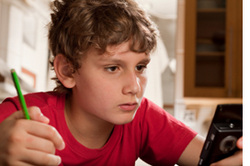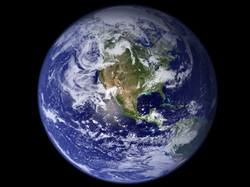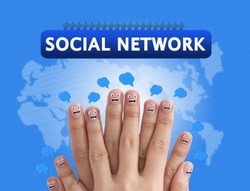Maggie Jackson has found through research the implementations and our interactions with television. Molly was her first case to study. She studied how she watched TV and noticed that she was not entirely zoned into the TV but that she was multitasking with other activities such as her phone and homework. This chapter discusses why we watch TV in the first place. We enjoy it. I feel that it too takes away from loneliness. The background noise takes away some of the silence and we feel as if we are in the presence of others. Maggie also argues that this concept of multitasking can also be dangerous because we remember more information when focus our attention on one thing instead of many. It limits our memories.
Questions Do you study with background noise? Do you feel you learn better with it? How has online TV changed how we view TV as well? Links: http://www.sciencedaily.com/releases/2006/07/060726083302.htm http://www.museum.tv/eotvsection.php?entrycode=televisionst
0 Comments
 Ito discusses the changes we have experienced with intimacy and families as new media evolves. Danah Boyd researched the Internet component of high school relationships and uses two examples; Amy and Michael., Amy is rarely allowed out of the house for dates so majority of their relationship occurred in school and online. Their relationship was public but so was their breakup and each had different reactions; Michael was angry and vented and Amy expressed emotions for other guys.
Bob Anderson however had a different experience. He met another boy online and though they never met he felt comfortable expressing himself and his issue to this stranger. This excerpt expresses Bob's appeal; "It was kind of a weird cyber growing-up thing. Just like checking in... I was finding out more about myself, and trying to figure out what I was about, and trying to figure out what people were about, and trying to figure out what the world was about" (142). Families have changed as well. One family of 4--three kids and a single, Spanish-speaking mother--and another family of 4--two kids with both parents. Each family encouraged their children to use media and learn through it. The Garcia family mainly interacted with the television and Lydia's cell phone; while the Miller family uses websites and other projects to include themselves in new media. Discussion Questions: Are these kinds of relationships detrimental to kids interaction with the opposite sex? Would you encourage your kids to be connected as much as these parents do with theirs? Where do you draw the line for your family and screen time? Links: http://www.barna.org/family-kids-articles/488-how-technology-is-influencing-families http://www.psychologytoday.com/blog/happiness-in-world/201006/the-effect-technology-relationships Gitlin, ”Nomadicity” (207-214) and OʼReilly, “What Is Web 2.0” (215-229) (in Digital Divide)4/23/2012  in Nomandicity, Gitlin talks about the development of the walkman. This seems like an ancient tool for my generation since it came out just a few years after our birth, but in fact in prompted the individualistic mindset people expected to have in their lives. He uses the term "Nomadicity" to discuss our way of life. A nomad is a person with no place of residency--the world is the their home. This is similar to how society operates today because "Wherever and whenever we move around, the underlying system always knows who we are, where we are, and what services we need." Our access to services that locate us, know us, and lead us, allows us to live in Nomadicity.
O'Reilly discusses the Web 2.0 generation and how we are without boundaries or principals that generations before us had. We have fewer limits and a greater reach with the Web 2.0--it is a source that ties us together; a collective intelligence. Discussion Questions: We are always linked and no matter where we are you have access to link with others through the web. Can you really be a nomad today? How does web 2.0 change our ethics? Links: http://searchmobilecomputing.techtarget.com/definition/nomadicity http://mashable.com/2012/03/16/encyclopedia-britannica-wikipedia-infographic/  These articles relate to each other through the distortion of pictures and their impactful effects on society. So many of the images we see are retouched and altered to seem more "beautiful" or "perfect" It creates an ideal standard of beauty for our culture that n one can live up to . Parents see the impact it has on their children and some are in argument about it. They want disclaimers on the photos to make known that these images are altered. Advertisers have also used fake portrayals of people who do not actually suffer from a disease in order to attract consumers. Photoshop has created a whole new idea in approaching advertisement and have caused consumers to be exposed to this unrealistic world. Links: http://www.usatoday.com/news/health/2007-02-19-sexualized-girls_x.htm Discussion Questions: When it is so easy to alter reality and the impact an image has on us, where do we draw the line? What ethical boundaries are we tampering with? Can these actions be justified?  In this chapter Jenkins focuses on the changes in our systems of communication. Photoshop and politics is the main focus of this chapter. Politics is a subject that often seems out of realm for younger generations. Jenkins argues that there are parodies that make politics available for these generations; they are a form of citizenship similar to an editorial in a newspaper. Is there an end in sight for these traditional forms of news? We do not know--we do know however that they are becoming less prevalent and we now seek to find more entertaining forms of news. Comedy Central spent more air time on the 2004 National Conventions than ABC, CBS, and NBC combined. However Jenkins argues that these popular forms of news are not replacing old forms of news such as broadcast news, but that it is simply transforming it. Convergence is changing our forms of news in the media and traditional systems need to recognize this to keep up.
Links: http://video.foxbusiness.com/v/1549733446001/drawing-the-line-between-news-and-entertainment/ http://www.nbc.com/saturday-night-live/video/categories/political-gallery/33501/ Discussion Questions: Where does most of your news come from? Is this convergence helpful or hurtful for truthful unbiased news? Can you make an informed decision with news solely from convergence sources like SNL, the Colbert Report, etc.?  This article addresses the questionability of social media. Ford says that social media has no understanding of anything aside from the connections between individuals and the "ceaseless flow of time: No beginnings, and no endings." He says that the world of old media is like a machine he calls the Epiphanator. The Epiphanator has always known the value of a meaningful conclusion. Life has depth and is complicated--we need to be able to explain its complexity and we cannot do this through the jumble of social media. Social media happens at the expense of face to face contact. These innovators, he claims, have created tools that give regular people "godlike powers" We've arrive at a point where anyone with internet access can be heard by millions of people. Ford says that new generations will go on in their new world of work and never miss the old forms of media, but the vibe he sends through is writing is that they are missing out. It is important that even with this we still have need of an ending.
Links: http://nymag.com/daily/intel/2011/07/new_media_innovators.html http://www.telegraph.co.uk/technology/facebook/8591849/Aaron-Sorkin-the-writer-of-The-Social-Network-has-left-Facebook.html Discussion Questions: Are we desensitized to tragedy because its so easily posted all over the internet and we are bombarded with so many different causes? Are we unable to articulate ourselves as well because our attention span is growing shorter over time and no one will read long wordy texts?  This chapter discusses how teenagers use new media for friendship. IT used to be that the mall was a place where teenagers would meet up, hang out, converse, and socialize but that spot has now been transferred into social media and online worlds. social sites like myspace and Facebook are a way that teenagers feel established, however it can both reinforce or hurt social bonds as well. Ito categorizes his explanation into 4 different areas; making friends, performing friendships, articulating friendship hierarchies, and navigating issues of status, attention, and drama. New media allows not only teenage participation but it has grown to appeal to all age groups. Its appeal is that we can connect with our friends at any given point in our day. For example, Ann became joined Facebook when she left for college and found use in the ability to get to know her roommate as well as others in her area. They could get to know each other before meeting face to face and talk about what their contributions to the room would be. Ann used social media to give structure to her social world--assessing and evaluating it, making it more comfortable of a situation, before actually being in the situation. Social media defies the geographic restrictions we once were so bounded by and our ability to connect with new people is astounding. This allows us to more readily develop communities.
Links: http://www.huffingtonpost.com/2011/11/11/teens-on-facebook-when-is_n_1088308.html http://kommein.com/an-open-letter-to-teens-who-use-facebook/ Discussion Questions: Do we have too many friends now? Are our relationships more disconnected because we are able to have many more friends than we used to? Does it make teen lives more dramatic and attention oriented (self-centered)? |

 RSS Feed
RSS Feed